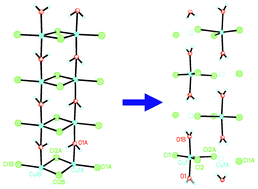Effects of halogen and hydrogen bonding on defect disorder: the ladder that wasn't there†
Abstract
The structures of four complexes of the formula (SpyH)2[CuCl3(H2O)2]Cl (S = 2-amino-5-iodo, 1; = 3-iodo, 2; = 5-amino-2-iodo, 3; = 2-amino-5-bromo, 4) are reported. The complexes crystallize in the monoclinic space groups P21/c (1 and 2) and P21/n (4) and the triclinic space group P![[1 with combining macron]](https://www.rsc.org/images/entities/char_0031_0304.gif) (3). The structure of complexes 1 and 2 is apparently a ladder parallel to the a-axis with the rungs formed by a bichloride bridge between two Cu(II) ions and the rails formed by linearly-bridging water molecules. These ladders are surrounded by stacks of the organic cations and stabilized by hydrogen and halogen bonds to the chloride ions. However, the two Cu(II)-ion sites are symmetry related and clearly present in only ½ occupancy. Thus, the real structure is that of discrete [CuCl3(H2O)2] units related by a 21-screw-axis parallel to the a-axis with an isolated chloride ion at each level held in place by hydrogen and halogen bonding. Only the position of the Cu(II) ion and the hydrogen atoms on the water molecules are disordered. The structures of 3 and 4 are similar, but the two Cu(II)-ion positions are not symmetry related and do not have equal occupancies (∼82 : 18 for 3 and ∼96 : 4 for 4). In essence, the balance of the chloride–Cu(II) ionic interactions, C–I/Br⋯Cl halogen bonding and pyridinium N–H⋯Cl hydrogen bonding has created a family of crystalline solids, in three distinct crystal forms from four distinct pyridinium moieties, with well-defined defects in the occupancy of the Cu(II)-ion sites. Variable temperature magnetic data show only very weak antiferromagnetic interactions (J < −1 K), as expected given that hydrogen bonding provides the only viable superexchange pathway.
(3). The structure of complexes 1 and 2 is apparently a ladder parallel to the a-axis with the rungs formed by a bichloride bridge between two Cu(II) ions and the rails formed by linearly-bridging water molecules. These ladders are surrounded by stacks of the organic cations and stabilized by hydrogen and halogen bonds to the chloride ions. However, the two Cu(II)-ion sites are symmetry related and clearly present in only ½ occupancy. Thus, the real structure is that of discrete [CuCl3(H2O)2] units related by a 21-screw-axis parallel to the a-axis with an isolated chloride ion at each level held in place by hydrogen and halogen bonding. Only the position of the Cu(II) ion and the hydrogen atoms on the water molecules are disordered. The structures of 3 and 4 are similar, but the two Cu(II)-ion positions are not symmetry related and do not have equal occupancies (∼82 : 18 for 3 and ∼96 : 4 for 4). In essence, the balance of the chloride–Cu(II) ionic interactions, C–I/Br⋯Cl halogen bonding and pyridinium N–H⋯Cl hydrogen bonding has created a family of crystalline solids, in three distinct crystal forms from four distinct pyridinium moieties, with well-defined defects in the occupancy of the Cu(II)-ion sites. Variable temperature magnetic data show only very weak antiferromagnetic interactions (J < −1 K), as expected given that hydrogen bonding provides the only viable superexchange pathway.


 Please wait while we load your content...
Please wait while we load your content...